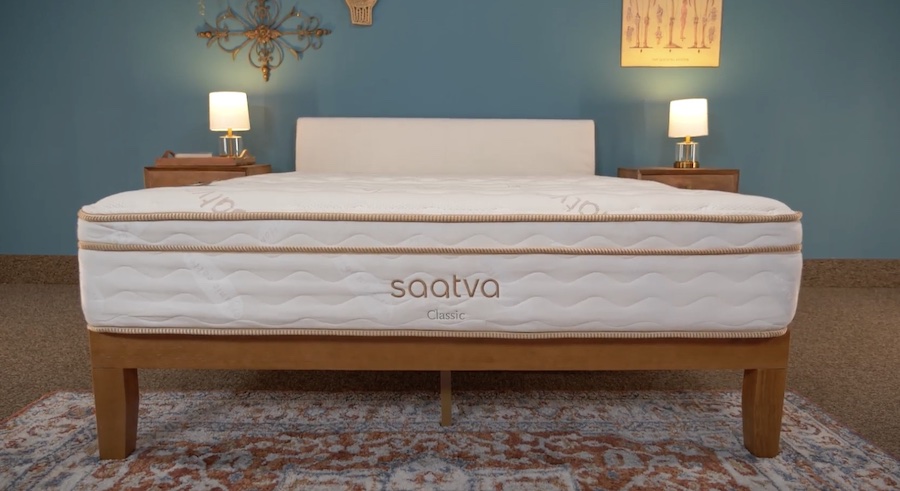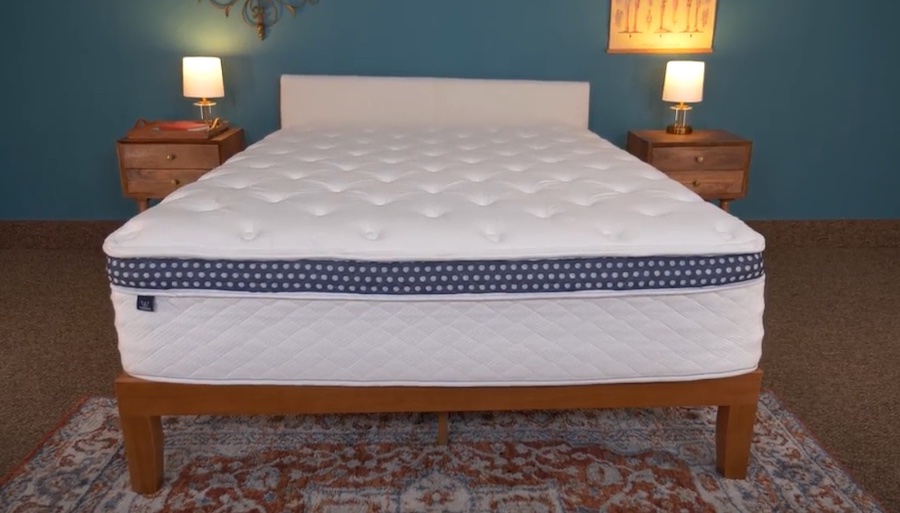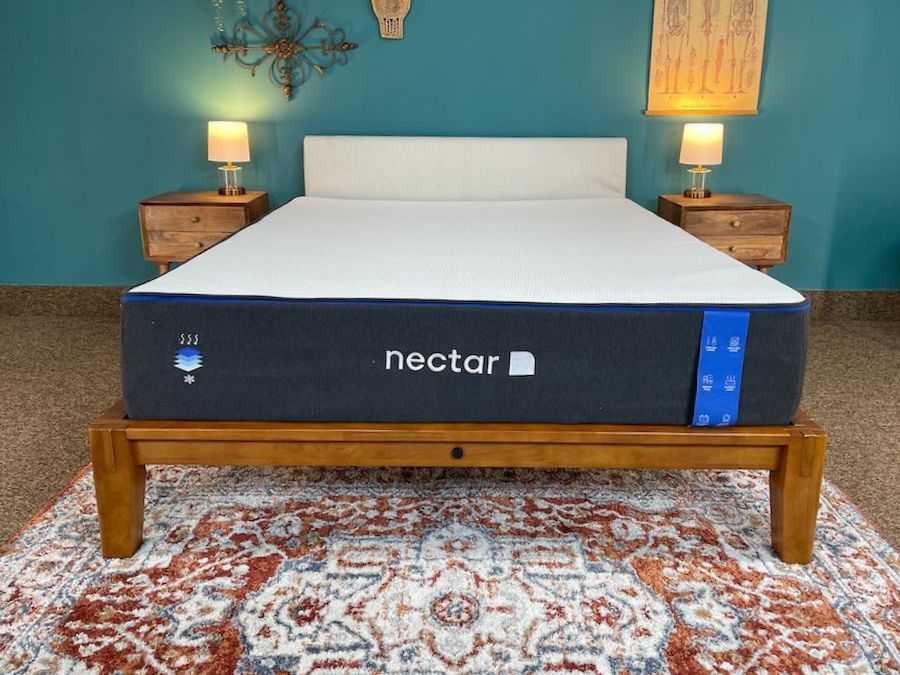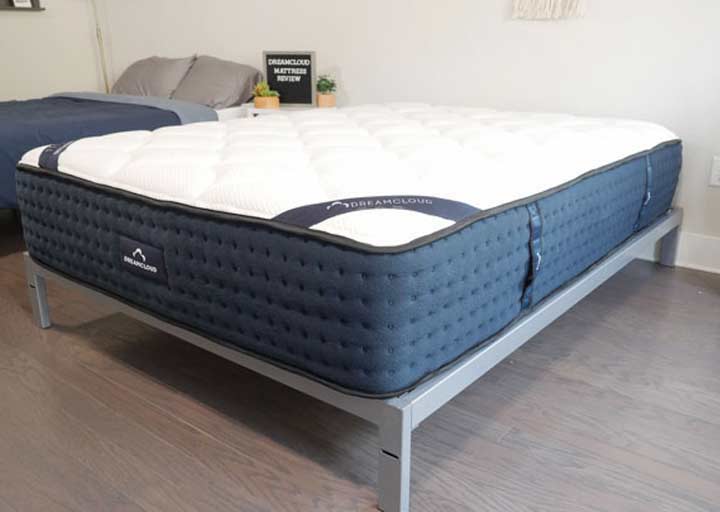Is there any difference in a Double vs. Full bed? Sometimes a Double bed is referred to as a Full bed and vice versa, but these both refer to the same size mattress.
Both terms are usually used interchangeably, depending on the region/dialect. Both labels are pretty much identical in dimensions and universally serve the same purpose.
With that out of the way, it is good to know the different nuances of bedding vocabulary so that you are sure to get the right amount of sleep space for your preferences.
Full vs. Double Mattress Comparison Chart
| Full Bed | Double Bed | |
| Width | 54 inches | 54 inches |
| Length | 75 inches | 75 inches |
| Price | Similar to Double, cheaper than a Queen, more expensive than Twin/Twin XL | Similar to Full, cheaper than a Queen, more expensive than Twin/Twin XL |
| Best For | Solo sleepers, guest rooms, smaller bedrooms | Solo sleepers, guest rooms, smaller bedrooms |
Sleep Experts Discuss Mattress Sizes
Best Full-Size Mattresses
- Saatva Classic – Editor’s Pick
- Helix Kids – Best Full-Size Mattress for Kids
- WinkBed – Best Full-Size Hybrid Mattress
- Nectar – Best Cheap Full-Size Mattress
- DreamCloud – Best Full-Size Mattress for Couples
Check out our full list of the best Full-size mattresses

|

|

|

|

|
|
| Saatva Mattress | Helix Kids Mattress | WinkBed Mattress | Nectar Mattress | DreamCloud Original Mattress | |
| Rating | |||||
| Firmness | Multiple firmness options | Multiple firmness options | Medium-firm: 6.5/10 | Medium-firm: 6.5/10 | |
| Material | Innerspring | Hybrid | Hybrid | Foam | Hybrid |
| Cooling |
|
|
|
— |
|
| Warranty | Lifetime warranty | 10-year warranty | Lifetime warranty | Lifetime warranty | Lifetime warranty |
| Shipping | Free white glove delivery | Free shipping | Free shipping | Free shipping | Free shipping |
| Trial Period | 365 nights | 100 Nights | 120 nights | 365 nights | 365 nights |
| Best For | Back Sleepers, Stomach Sleepers, Back Pain, Hot Sleepers | Side Sleepers, Back Sleepers, Stomach Sleepers, Kids, Hot Sleepers | Back Sleepers, Stomach Sleepers, Back Pain, Hot Sleepers, Side Sleepers | Back Sleepers, Side Sleepers, Hip Pain, Joint Pain | Back Sleepers, Hot Sleepers, Seniors |
Are Full and Double Mattresses the Same Size?
Yes, Full and Double mattresses are the same size. The names “Full” and “Double” are basically two ways of saying the same mattress size. Therefore, if you purchase a Full-size bed, you can expect the same dimensions that you’d get with a Double, and vice versa.
Want to know more? Check out our complete mattress size guide here.
What to Consider When Choosing a Full or Double Mattress
Dimensions
Typically, a Full/Double bed will be 54 inches wide by 75 inches long, meaning that it can accommodate about 27 inches of width per person. However, some sleepers may feel that this size is not wide enough to comfortably accommodate two people, meaning that it may not be a good fit for couples
Price
Full/Double beds are typically a budget-friendly option. They are usually more expensive than a Twin, but they give you additional room to stretch out or sleep beside your pet. Queen beds, the most popular mattress size, are wider, longer, and often thicker than Full beds, but they are also going to cost more.
The price of Full-size beds can make them appealing for kids’ rooms or guest rooms. Also, a Full/Double bed’s affordability can make them a great fit for young adults living on their own for the first time. Bedding accessories for this size mattress can be found at reasonable prices as well.
More: Best Twin Mattress
Comfort
A comfortable bed is one of the key components to a quality night’s sleep. Full mattresses come in a variety of styles, including traditional innerspring, memory foam, latex, and hybrid models. To achieve optimal comfort, you will want to consider how your preferred sleeping position and body weight will interact with the type of Full-size mattress that you choose.
These beds can make an excellent choice for adults and children who sleep alone because it will give them more room to stretch out than when sleeping on a Twin. However, Full beds may be too short for taller sleepers. If you are over 6 feet tall, you may want to consider a Twin XL or a Queen.
Bedding
The type of bedding that you use on your Full mattress can add to its coziness and overall comfort. Considering that this size bed is popular, you should have no problem finding Full sheets and other accessories in the style and material that you prefer.
If you like to wrap yourself in a big quilt or comforter, you can often find ones that can be used on either a Full or Queen. If you use a Full/Queen comforter or quilt on your Full bed, you will likely have extra room to snuggle in. However, given the different dimensions of Fulls and Queens, sheets are not offered in this combo style and are not interchangeable between the two sizes.
More: Best Sheets
Room Size
Most standard bedrooms are around 10 feet by 10 feet or 10 feet by 12 feet, whereas the majority of master bedrooms come in around 12 feet by 14 feet or 12 feet by 16 feet. Full/Double beds can often be a good fit for standard bedrooms because they won’t overwhelm the space nor look swallowed up by the room.
Full and Double-Size Mattress Pros and Cons
Full and Double-Size Mattress Pros:
- Provide individual sleepers with more room than Twin beds
- Easy to find a variety of stylish bedding accessories
- Less expensive than a Queen
Full and Double-Size Mattress Cons:
- Couples may not have enough space to sleep together comfortably
- Taller sleepers may not be able to stretch out
- More expensive than Twin beds
- May look underwhelming in a larger master bedroom
Who Are These Sizes Good For?
This size is a good pick for people who sleep in a smaller room but still want something big enough to roll around on without having to downsize to a Twin.
A Full is also a good pick for solo sleepers and may even work for some couples who don’t have as much space in their bedroom or are just not ready to move up to a Queen.
Want to know more? Check out our complete mattress size guide here.
FAQs About Double vs. Full Mattress
Can two adults sleep on a Full-size mattress?
Yes, there is enough space for two average-size people to sleep on a Full bed, but it won’t leave a lot of room for repositioning or stretching out. A Full mattress is typically 54 inches wide by 75 inches long. Therefore, when two people share a bed of this size, each person should have approximately 27 inches of sleeping space. This is almost a foot less than what an individual would have sleeping on a Twin bed, which usually comes in around 38 inches wide.
Is a Double a Full or a Queen?
Double and Full beds are the same size. The only difference between them is that some people call them Full mattresses, while others refer to them as Doubles. However, Queen mattresses are different from these beds. Full/Double beds are typically around 54 inches by 75 inches, and Queens are bigger at 60 inches by 80 inches.
What’s the best mattress size for couples?
Ultimately, the best mattress size for your partner and you is one where you are both comfortable and obtain quality sleep. The most popular mattress size for couples is Queen.
Queen beds give each person more room than they would have if they were sleeping solo on a Twin bed, and they provide more space than a Full-size mattress. However, some couples may opt for even more sleeping space and choose a King-size bed. Couples who also sleep with a pet may find that a King bed fits their needs best.
Is a Standard mattress the same size as a Full or Double?
Generally, what is considered “standard” will vary from country to country, but this is a “Twin” size in the United States, which measures 38 inches by 75 inches.
What is a Small Double mattress?
This, which also goes by the term “three-quarter bed,” measures 48 inches by 75 inches, meaning it might be a good fit for someone who sleeps alone but requires a little more space than Twin sizes. Typically, these are not usually recommended for more than one person.
What is a Double XL mattress?
A Double XL, also referred to as a Full XL, offers more length than regular Double beds, measuring 54 inches by 80 inches, instead of 54 inches by 75 inches. This could help give additional legroom to those who are taller.
Do manufacturers still use the term “Double?”
These terms are interchangeable, so it is still used, though “Full” is more commonplace. Knowing that the two are equal can help clear up confusion, as sometimes one can be mistaken for another size and throw consumers off.
Conclusion
Now that you know Double and Full are two words for the same size mattress, you can have more confidence going into your search for a new bed. To recap, Full mattresses are great for solo sleepers and parents who want a bed their kid can grow into, and while some couples may get this size out of necessity, we advise going with at least a Queen (or larger) for those who sleep with a partner. This is also a common size, so you shouldn’t have any issues finding lots of bedding selections.

Jill Zwarensteyn
Editor
About Author
Jill Zwarensteyn is the Editor for Sleep Advisor and a Certified Sleep Science Coach. She is enthusiastic about providing helpful and engaging information on all things sleep and wellness.
Combination Sleeper